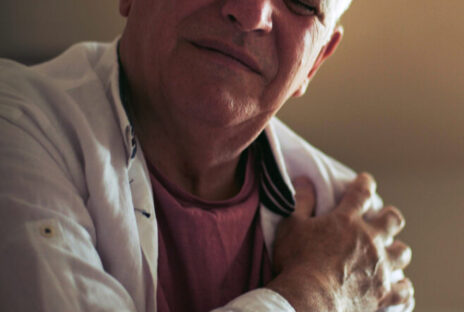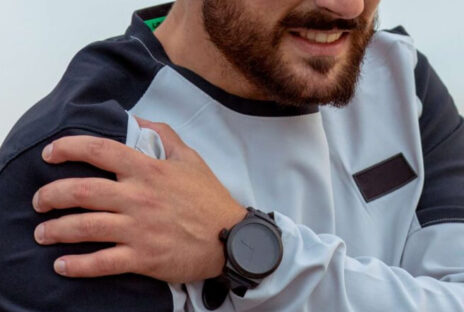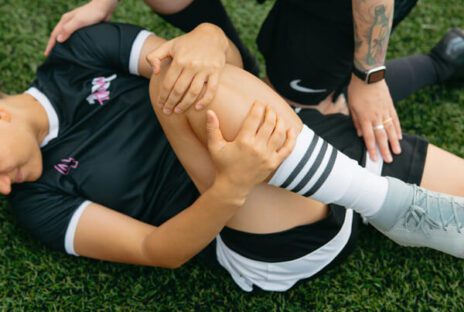When are ACL injury symptoms serious enough to see a physician?
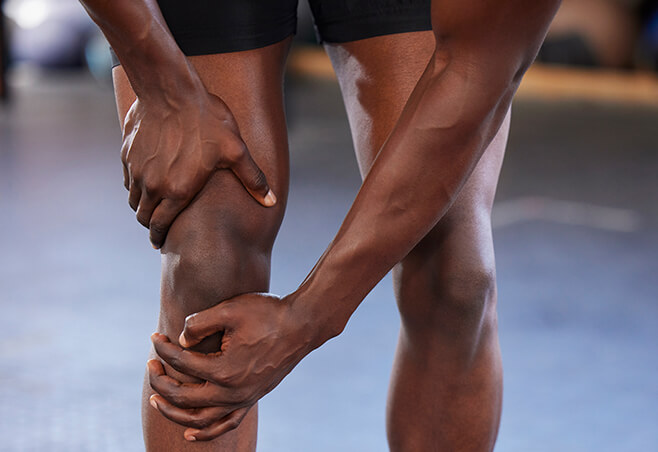
ACL injury symptoms include a sudden pop in the knee and intense pain—and often a little voice in your head that says, “I can’t believe I hurt myself that way.” Perhaps you were dancing like Elaine from Seinfeld at a wedding or putting a little extra into your golf swing. Then there’s the classic, “I wasn’t doing anything. I just stood up from my chair.” ACL injuries are equally common in sports and at random moments in everyday life.
In addition to the pop and pain, ACL injury symptoms include a swollen knee that feels unstable and hurts when bearing weight. Walking on a mildly injured ACL is possible, but usually not on a full tear. A cold foot that turns blue could indicate a knee dislocation, which should be treated as an emergency. Any sign that you’ve hurt your ACL should be taken seriously and addressed immediately.
Keep reading to learn more about the causes of ACL injury symptoms, what to do and when to see a knee physician.
Where is your ACL?
The ACL (anterior cruciate ligament) is located deep in the middle of the knee toward the front. It connects the thigh bone (femur) to the tibia (shin bone) just below the kneecap (patella). The main purpose of the ACL is to stabilize the knee when it rotates.
What causes an anterior cruciate ligament injury?
ACL injury symptoms are caused after your knee twists under forceful, downward pressure. They are common among athletes in professional and recreational sports that involve these movements:
- Landing from a jump,
- Changing direction suddenly (pivoting),
- Stopping or slowing suddenly (deceleration) and
- Direct collision.
What’s the difference between ACL sprains and tears?
All damaged ligaments are sprains and are graded on a scale of one to three. However, the word “sprain” is most commonly limited to ACL injury symptoms associated with a mild injury. In contrast, worse injuries are called “tears” because part or all of the ligament is ripped through.
- Grade 1 sprain: A stretched ligament that remains strong enough to stabilize the knee (you can typically still walk on it)
- Grade 2 sprain: A ligament stretched to the point of looseness (also called a partial or micro-tear)
- Grade 3 sprain: A ligament torn all the way through or separated from the bone (also called a complete tear)
Partial vs. complete ACL tears
Complete tears of the ACL are more common than partial tears. In partial tears, some of the ligament fibers may be completely torn, but not all of them. In a complete tear, all of the fibers are torn through.
- Partial tears: Walking is usually possible immediately after the injury but is often painful. They may or may not require surgery.
- Complete tears: Walking isn’t usually possible immediately following the injury. Complete tears have ACL injury symptoms that often include severe pain and swelling. They typically require surgery, except in some older, sedentary patients.
Signs you might have an injured ACL
An ACL sprain is one of the most common ligament injuries in the body, affecting up to 400,000 people every year. Usually, the cause of an ACL injury is acute and sudden. Many people say they knew exactly when it happened.
Those with mild to moderate injuries to their ACL may still perform regular activities like sitting, standing, and walking with little or no discomfort.

What does ACL pain feel like?
Sprains and tears cause a combination of these ACL injury symptoms:
- Popping sensation at the time of injury,
- Acute sharp, noticeable pain, made worse by bearing weight or twisting,
- Possibly severe pain,
- Mild to total knee instability and
- Stiffness from swelling.
Even if your symptoms subside after a few days, you may still have ligament damage that requires evaluation by a knee specialist.
Where is ACL pain located?
The spot of the pain helps to distinguish ACL injury symptoms from signs of other potential knee problems. The characteristic location of pain is:
- Center of the knee
- Back or outside of the knee
Pain at the inner part of the knee or the top of the kneecap isn’t typically associated with an isolated ACL injury.
What does an injured ACL look like?
These are only a few visible signs of an injured anterior cruciate ligament:
- Swelling within a few hours
- Walking with a limp
Conditions sometimes mistaken for ACL damage
There are three bones and four major ligaments in the knee. ACL injury symptoms may overlap with other knee conditions. If symptoms don’t respond to rest and at-home remedies, see a knee specialist for an accurate diagnosis and proper treatment plan. The symptoms could be a sign of one of these other knee afflictions:
- Kneecap (patella) dislocation,
- Meniscus tear,
- Patella tendon tear,
- Quadriceps tendon tear,
- MCL sprain and
- Arthritis.
Patella Dislocation
The symptoms of a patella dislocation are very similar to those of an ACL tear and are often confused. The knee cap can dislocate and slide back in almost immediately, causing a “pop” with the knee giving out and associated pain, swelling and difficulty walking. A thorough physical examination of the knee can distinguish between these two injuries.
Meniscus tear
The meniscus is a shock absorber in the knee joint, with one on each side between the femur and the tibia. A meniscus tear mimics ACL injury symptoms with a popping sound during a twisting motion. However, the swelling and stiffness typically will present after a couple of days rather than after a couple of hours. The tear may also cause a catching or locking feeling in the knee.
Tendon tear
The patellar tendon connects the kneecap to the shinbone. A tear or rupture can mirror ACL injury symptoms and happen during the same activities. However, a torn patellar tendon might create an indentation below the kneecap, and the kneecap will be higher up the leg since it’s no longer attached to the bone below it.
With a quadriceps tendon rupture, the opposite occurs. The quadriceps tendon connects the thigh muscle to the top of the kneecap. When the quad tendon tears, there will be an indentation above the kneecap, and the patella will be lower than normal since the tendon is no longer pulling the kneecap up to its normal position.
MCL tear
The MCL (medial collateral ligament) is located on the inside of the knee, where pain from a tear occurs. The cause is typically a blow or hit to the outside of the knee, which pushes the knee inward and stretches the MCL. Unlike kneecap dislocations and tendon tears, the indicators of a medial collateral ligament injury are less like those of an ACL injury. Patients usually have less pain and swelling localized to the inside part of the knee only and maintain the ability to walk on the injured leg.
Arthritis
Arthritis in the knee affects the articular cartilage, not the ligaments. It’s more likely to feel like a deep ache rather than a sharp pain, often occurring gradually over time.
Care for ACL injuries
Many ACL injury symptoms improve without surgery. Immediately apply ice, stay off the knee, and take over-the-counter anti-inflammatory medication until you can see a knee specialist to determine the severity of the injury.
How ACL injury symptoms are used in the diagnosis process
Physicians can diagnose most ACL sprains through a physical examination. Your physician will look at the site of the swelling, touch and move areas around the injury, and compare the injured knee to the other knee. An MRI is typically ordered to confirm the diagnosis, determine the severity of the tear, and check for damage to other structures in and around the knee.
Lachman Test
The Lachman Test is the most reliable exam for a torn ACL performed in a physician’s office. With the patient lying down, the physician holds the leg in one hand and the thigh in the other thigh flexes the knee slightly, and applies gentle pressure to the joint.
Treatment for ACL injuries
The physician’s recommendations consider the severity of the ACL injury plus the patient’s age and lifestyle goals. In the case of a complete tear, surgery is often necessary for those who want to return to playing sports or have a physically demanding job.
Less active patients may regain their quality of life by following at-home knee ligament Injury treatment guidelines, going to physical therapy and wearing a brace when they resume certain activities.
FAQs about ACL injury symptoms
If you’re worried about an injury to your ACL—or thinking ahead to try and prevent one—here are answers to the most common questions.
Are ACL injuries more common in females?
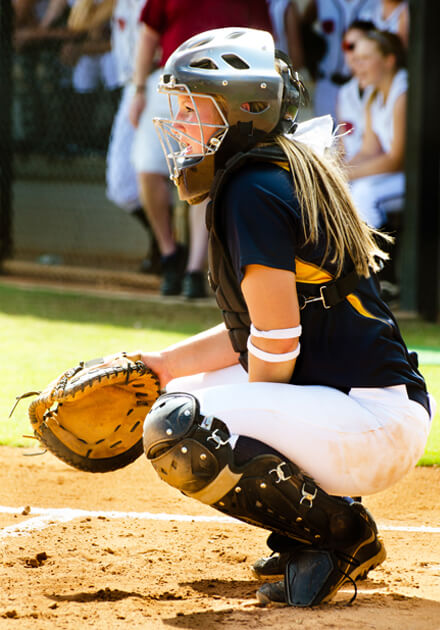
Female athletes are at an alarmingly higher risk than males for experiencing a sports knee injury to their ACL, especially if they play soccer and basketball. This increased risk in women is believed to be linked to several factors, such as differences in muscular strength, neuromuscular control, pelvis and lower leg alignment, space available for the ACL (notch stenosis), as well as the effects of estrogen and loose ligaments in general. Also, women tend to land from a jump by turning their knees inward, leading to more stress on the ACL. Women can reduce the risk of ACL injuries with appropriate warm-up and conditioning, neuromuscular strength training, diligent recovery, increasing balance and flexibility, avoiding overtraining and maintaining good nutrition.
Does a torn ACL hurt all the time?
Most ACL sprains cause some initial pain based on the severity of the injury. However, a partial or complete tear can quickly become asymptomatic when sitting, lying, or walking. You may notice instability without significant pain.
How long does an injury to the ACL take to heal?
Minor ACL injury symptoms can subside in a few weeks. Expect to sit out from sports for six to eight weeks for a partial tear and six to eight months or longer for a complete tear.
Is a meniscus tear worse than an ACL tear?
A meniscus tear is a less severe injury than an ACL tear. An isolated torn meniscus may require surgery but has a quicker recovery and return to sports time when compared to ACL tears.
Can an ACL tear heal on its own?
An ACL tear does not usually grow back or “fix” itself. The initial pain and swelling after an ACL injury will resolve with time and rehabilitation, and patients can return to normal daily function. However, returning to sports and activities (that require jumping, pivoting and changing direction) often require surgical intervention to restore knee stability.
Do cortisone shots help a torn ACL?
Yes, a cortisone injection can effectively decrease ACL injury symptoms like pain and swelling, which can help speed up the physical therapy rehabilitation and return to normal daily function. However, cortisone shots don’t stimulate any ligament healing and aren’t commonly used to treat minor injuries to an ACL.
Get back on your feet with FOI
ACL injuries come in various shapes and sizes, and the knee experts at Florida Orthopaedic Institute have seen them all. If you’re experiencing any ACL injury symptoms, visit one of our many locations across central Florida for convenient, state-of-the-art care tailored to your injury and lifestyle.
FOI’s knee specialists provide comprehensive services (such as injections, diagnostic testing, bracing, physical therapy and surgery) that allow patients to customize the fastest, safest and most effective treatment plan to help them reach their goals.
Schedule with a physician or request an appointment to discuss your injury.
You might also like:
- Which Sports Knee Injury Do I Have?
- Is My Swollen Knee a Reason to See a Physician?
- Patient Story: ACL Injury During High School Lacrosse
- Stepping Back onto the Soccer Field After an ACL Injury
- Pain Behind Knee and Calf—Here’s What It Could Mean
January 3, 2025
